Star Trek: The Boardgame Generation – Episode Two
As w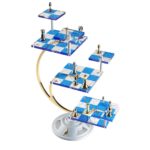 e celebrate the 50th anniversary of the Star Trek franchise, “Trek-ifiying” things is rampant and the world of boardgaming is no exception. While there are probably Star Trek versions of Monopoly, Risk, and Trivial Pursuit, I intend to take a look at Star Trek versions of games popular with boardgame hobbyists. These games, sometimes called Eurogames (since they are popular in Europe) or designer boardgames (as the game designers are recognized for their efforts just like authors or directors) are popular as they emphasize player interaction and minimize luck and player elimination. Episode 2 deals with a couple games best for more serious strategy gamers.
e celebrate the 50th anniversary of the Star Trek franchise, “Trek-ifiying” things is rampant and the world of boardgaming is no exception. While there are probably Star Trek versions of Monopoly, Risk, and Trivial Pursuit, I intend to take a look at Star Trek versions of games popular with boardgame hobbyists. These games, sometimes called Eurogames (since they are popular in Europe) or designer boardgames (as the game designers are recognized for their efforts just like authors or directors) are popular as they emphasize player interaction and minimize luck and player elimination. Episode 2 deals with a couple games best for more serious strategy gamers.
Star Trek: Frontiers
 3-4 Players
3-4 Players
Time: 60-90 minutes
Rating: Serious Gamers
Of all the Trek themed games I’ve played, Star Trek: Frontiers (a rethemed version of the strategy game Mage Knight) comes closest to the theme of the Star Trek shows. In Frontiers, just like the shows, players take on the role of a starship captain exploring the unknown universe (full of Romulans, Dominion, and the Borg.) Players play as one of four different characters (2 human, 2 klingon), each having special powers. The “universe” in this case are interlocking hexagonal tiles that are slowly revealed as players move their ships further and further into the unknown. When tiles are revealed, appropriate locations are added to the board: enemy ships, various kinds of planets, starbases, outposts, and even Borg Cubes (the big bad guys found at the end of the game.) Many places allow for combat (space or away missions), while other locations allow more more peaceful pursuits (hiring crew or repairing.)
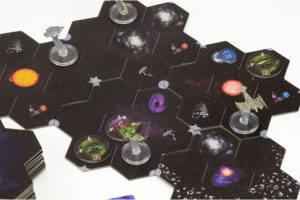
The heart of the game focuses on a deck of cards (each player has one unique card to add a bit of difference.) A the start of each round, players have a full hand of cards. They may play as many cards as they wish on their turn, refilling their hand from their deck at the end of their turn. Cards are used for movement, offense, defence, purchasing other cards (diplomacy) and occasional special effects. Each card has an ability and most have a bonus, more powerful ability that can be used by spending the appropriate color resource.
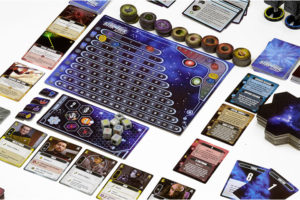
Players can use one temporary resource (from a pool of dice) per turn, and special circumstances may allow a player to gather long-term resources that can be stored for later turns. Players continue to take turns until someone starts a turn with an empty deck and forfeits their turn to declare the end of the round. Each player gets one additional turn and the round ends. Thus, a player can save up cards to have a more powerful turn, or try to burn through their deck quickly to end the round before others can finish theirs. The game continues until the victory conditions are met. There are several scenarios available including some cooperative ones (suitable for solo play if you wish), some very competitive, and others a mix of the two. Most scenarios include finding and defeating one or more of the very powerful Borg Cubes, but the winner is determined by a player’s overall score which includes exploration, conquests, and crew members with a small bonus to the player with the most in any given category. Experienced players can finish a short scenario (4 rounds) in about an hour, while longer ones (6 rounds) with several players can approach the two hour mark.
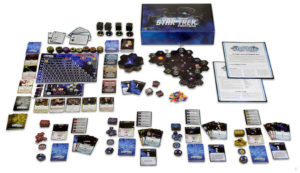
Throughout the game, players become more powerful in several ways. New, more powerful cards can be found or purchased to increase the size and strength of one’s deck. Crew members can be recruited that can be used on away missions or provide a bonus once per round. Finally, as players complete tasks and gain experience they increase their character’s level, gaining special abilities (unique to that character), increasing their hand size, and increasing the size of their crew. There is always a juicy upgrade around the next corner so players have something for which to strive.
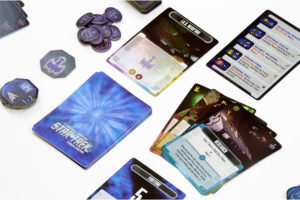
Conclusion:
I won’t deny the game is fairly complex, but the basic mechanisms are quite approachable. The more advanced rules and options naturally flow out of encounters and cards found as players progress deeper into unexplored space. The idea of venturing out into the unknown to explore, defend, and conquer fits perfectly into the Star Trek ideals. Players can even choose to be “evil” and conquer or destroy planets and space stations to gain short-term gains at a cost of long term (diplomacy) penalties. A strong game, with a very fitting theme, makes Star Trek: Frontiers a great game for players willing to tackle a more complex (and lengthy) game.
Star Trek: Ascendancy
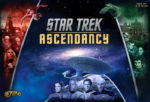 3 Players
3 Players
Time: 90-180 minutes (about an hour per player!)
Rating: Serious Gamers
While other Star Trek games have an option for cooperation, Star Trek: Ascendancy is primarily an all-out war like an elegant Star Trek version of Risk or Axis and Allies. The game comes with three races (Federation, Klingon, and Romulan,) each with their own strength and weaknesses. It is a 4X game (involving eXploration, eXpansion, eXploit, and eXterminate) with a strong Star Trek theme.
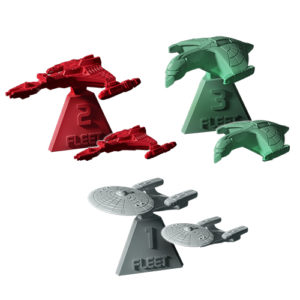
Players begin the game on their home planet and must use their starships to eXplore new locations. Each planet has a specific number of space lanes, when a player launches their ship into a lane, a die is rolled to find the length of the lane and a “planet” tile is drawn from the stack to represent the destination. In a unique mechanism, whenever a new planet is discovered, players are allowed to “swing” the “arm” of the space lane around the board to configure it however they want (barring some rules preventing overlapping lanes, etc…) Of course, connect a planets to two others and it will be fixed to that location.. Rotating the space lane attached to a new planet is a strategic move, as players can maneuver planets in order to reduce the distance from their front lines to the opponent’s area and home world while trying to simultaneously protect their own home world. Not all “planet” tiles are planets, some are “phenomenons” which can be examined for research points. If a planet is discovered (and ships survive any hazard roll needed for hazardous systems) the player draws an exploration card that determines the type of planet. Planets may contain hazards, discoveries, virgin worlds ripe for colonization, or planets already inhabited with a civilization.

After eXploring worlds, they are ripe for eXpansion. Virgin worlds can be colonized and occupied worlds (neutral ones or opponents’) can be conquered and added to one’s empire. Once they are brought under control they can be eXploited. There are three main resources in the game: culture, production, and research. Each planet can produce one or more of these resources if a player builds a resource node. Production is used for constructing just about everything (ships, resource nodes.) Research is used to improve one’s abilities such as ship offense or defense to help during combat. Each race also has their own stack of special ability cards that can be researched over time to give a player new, unique powers during the game such as faster travel or additional actions. Culture is used to colonize new planets, “peacefully” take over occupied planets, and can be cashed in for Ascendancy tokens. Collect 5 Ascendancy to win a cultural victory. Not all interspecies interactions involve combat, and players can form trade agreements, giving both parties additional resources during their turns. Of course, these become null and void once either party turns around and betrays the other.
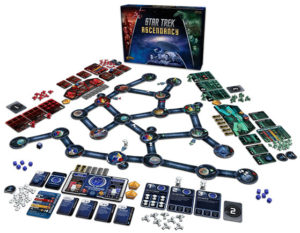
Betrayal arises from combat, and if you don’t want to win a cultural victory, eXtermination (and a supremacy victory) will have to do. Players build ships to explore but also use them in combat against other players and their planets. Combat (at least without researched technology) is a relatively simple affair, rolling dice and comparing to target numbers determined by one’s own attack and the opponent’s defensive scores. In addition to individual ships, players can group ships together onto one of three double-sided “fleet” cards. Each card has a minimum and maximum number of ships it can contain. A fleet travels together on the board and also enjoys a minor advantageous effect listed on the card (each race has slightly different fleet cards.) Conquer and control three home planets (your own counts) and you win a supremacy victory.
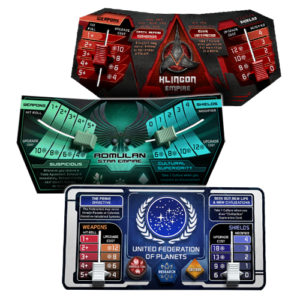
Conclusion:
This is not a simple game like Risk, but the extra effort to learn the rules pays off in a dividend of a fun Star Trek style romp through the galaxy. It is long, and has many rules but they “make sense” so that new players can quickly get up to speed. Thankfully, the rules are clean and contain an complete example of one player’s first turn. The rules also provide several options to speed up the game, such as starting with some technology and/or resources or simply requiring less culture to reach Ascendancy. Currently, the game can only be played with 3 players (one per each starting race) but expansions coming out later this fall add in new races (Cardassian and Ferengi) which would allow more players to play (with an appropriate lengthening of the game.)
It is not easy to construct a 4X game that plays quickly and yet contains all the elements that make the genre popular. Star Trek Ascendancy does a good job providing a solid 4X style of play. WIth the randomly drawn planets and space lanes, the eXploration part of the game is covered. I also appreciate the balance of eXploit and eXterminate, allowing players to pursue the path to victory that they prefer. Players willing to put the requisite time into playing the game will find a very satisfying and (Star Trek) thematic game of galactic proportions.





Discussion Area - Leave a Comment